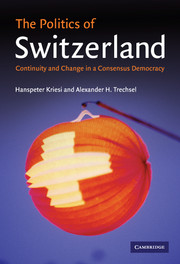Book contents
- Frontmatter
- Contents
- List of figures
- List of tables
- Preface
- List of abbreviations
- 1 The development of the modern Swiss nation-state
- 2 Neutrality
- 3 Federalism
- 4 Direct democracy
- 5 The Swiss system of government
- 6 The party system
- 7 Interest associations and labour relations
- 8 The decision-making process
- 9 Economic policy: liberalization under constraints
- 10 Social policy: the Swiss welfare state
- 11 Foreign policy: Switzerland and the EU
- Appendix
- References
- Index
1 - The development of the modern Swiss nation-state
Published online by Cambridge University Press: 05 September 2012
- Frontmatter
- Contents
- List of figures
- List of tables
- Preface
- List of abbreviations
- 1 The development of the modern Swiss nation-state
- 2 Neutrality
- 3 Federalism
- 4 Direct democracy
- 5 The Swiss system of government
- 6 The party system
- 7 Interest associations and labour relations
- 8 The decision-making process
- 9 Economic policy: liberalization under constraints
- 10 Social policy: the Swiss welfare state
- 11 Foreign policy: Switzerland and the EU
- Appendix
- References
- Index
Summary
State formation
Until the French Revolution, the Swiss Confederation remained no more than a loose alliance of thirteen cantons with strong ties to allied territories such as Geneva, Grisons or Valais, plus subject territories (e.g. Vaud, Argovia, Thurgovia, Ticino or Valtellina) of their component units or of the federation as a whole. The Confederation exercised only limited governmental capacity. The only stable institution that the Thirteen and their allies maintained was a permanent assembly of delegates – the Diet, which met regularly in order to discuss matters of common interest, especially of war and peace. Together with the ancient pact from the thirteenth century and some other agreements, the national peace treaties, concluded after the religious civil wars in the sixteenth and seventeenth centuries, constituted the fundamental law of the Confederation (Körner 1986: 398). Most importantly, in the first peace of Kappel in 1529, which had put a temporary end to the war between the cantons that had converted to the new Protestant creed and the cantons that remained Catholic, the belligerents had promised to no longer interfere in each other's religious affairs. The formula chosen already stated the principle of what would later become a ‘defensive’ kind of federalism. The second peace of Kappel confirmed the preceding formula in 1531: each camp promised to respect the religious choices made by the other one.
- Type
- Chapter
- Information
- The Politics of SwitzerlandContinuity and Change in a Consensus Democracy, pp. 1 - 17Publisher: Cambridge University PressPrint publication year: 2008



